Predicting of the Unit Grouting Quantity in Karst Curtain Grouting by the Water Permeability of Rock Strata
Abstract
:Featured Application
Abstract
1. Introduction
2. Study on the Relationship between the Unit Grouting Quantity and the Water Permeability of Rock Strata in Karst Curtain Grouting
2.1. Analysis of the Relationship between the Unit Grouting Quantity and the Water Permeability of Rock Strata
2.2. Establishment of Theoretical Relationship between the Unit Grouting Quantity and the Water Permeability of Rock Strata
3. Application Verification of Typical Karst Curtain Grouting Project
3.1. Engineering Background
3.2. Hydrogeological Conditions of Working Area
3.2.1. Law of Karst Development in Working Area
3.2.2. Characteristics of the Water Permeability of Rock Strata in Working Area
3.3. Engineering Application of Prediction Method of the Unit Grouting Quantity in Karst Curtain Grouting Based on the Water Permeability of Rock Strata
3.3.1. Prediction of the Unit Grouting Quantity in Curtain Grouting in the Area of Strong Karst Development by Using the Water Permeability of Rock Strata
3.3.2. Prediction of the Unit Grouting Quantity in Curtain Grouting in the Area of Weak Karst Development by Using the Water Permeability of Rock Strata
4. Discussion
4.1. Parameter Analysis
4.2. Applicability and Limitation of the Prediction Method of the Unit Grouting Quantity in Karst Curtain Grouting Based on the Water Permeability of Rock Strata
5. Conclusions
- (1)
- The theoretical relationship between the unit grouting quantity and the water permeability of rock strata in karst curtain grouting can be expressed in the form of power function. The theoretical equation contains only the parameter , which is the comprehensive characterization of the characteristics of slurry fluid, the characteristics of grouted rock strata, and the technical factors of grouting in karst curtain grouting, and its value is determined by field tests and data fitting.
- (2)
- Based on the theoretical relationship between the unit grouting quantity and the water permeability of rock strata in karst curtain grouting, the proposed method can be used to reasonably predict the required unit grouting quantity in karst curtain grouting construction. The procedure is as follows: (i) According to the hydrogeological conditions of the construction area of karst curtain grouting, the suitable curtain grouting test section is selected to carry out the field test, and the data of the unit grouting quantity and the water permeability of rock strata obtained in the test are recorded. (ii) Using the test data and nonlinear function fitting, the comprehensive coefficient of karst curtain grouting is determined; and (iii) according to the theoretical relationship equation between the unit grouting quantity and the water permeability of rock strata in karst curtain grouting, the required unit grouting quantity is predicted by using the water permeability of rock strata obtained in the main project.
- (3)
- The relationship equation between the unit grouting quantity and the water permeability of rock strata in the karst curtain grouting obtained by theory (Equation (16)) is consistent with the fitting equation obtained in the typical case of karst curtain grouting project (Equations (17) and (18)), indicating that the theoretical equation can be effectively applied to predict the unit grouting quantity in the karst curtain grouting.
- (4)
- In the engineering case, it is obtained that the comprehensive coefficient of karst curtain grouting is 24.37 in the area of strong karst development and 16.51 in the area of weak karst development. It can be applied respectively to predict the unit grouting quantity in the main project of karst curtain grouting in the area of strong karst development and the area of weak karst development.
Author Contributions
Funding
Acknowledgments
Conflicts of Interest
References
- Guo, F.; Jiang, G.H.; Yuan, D.X.; Polk, J.S. Evolution of major environmental geological problems in karst areas of Southwestern China. Environ. Earth Sci. 2013, 69, 2427–2435. [Google Scholar] [CrossRef]
- Zheng, X.H.; Liu, L.; Sun, J.Z.; Li, G.; Zhou, F.B.; Xu, J.M. Imaging of underground karst water channels using an improved multichannel transient Rayleigh wave detecting method. PLoS ONE 2018, 13, e0199030. [Google Scholar] [CrossRef] [PubMed]
- Ren, D.J.; Shen, S.L.; Cheng, W.C.; Zhang, N.; Wang, Z.F. Geological formation and geo-hazards during subway construction in Guangzhou. Environ. Earth Sci. 2016, 75, 1–14. [Google Scholar] [CrossRef]
- Cui, Q.L.; Shen, S.L.; Xu, Y.S.; Wu, H.N.; Yin, Z.Y. Mitigation of geohazards during deep excavations in karst regions with caverns: A case study. Eng. Geol. 2015, 195, 16–27. [Google Scholar] [CrossRef]
- Yilmaz, I. GIS based susceptibility mapping of karst depression in gypsum: A case study from Sivas basin (Turkey). Eng. Geol. 2007, 90, 89–103. [Google Scholar] [CrossRef]
- Li, S.C.; Zhou, Z.Q.; Li, L.P.; Xu, Z.H.; Zhang, Q.Q.; Shi, S.S. Risk assessment of water inrush in karst tunnels based on attribute synthetic evaluation system. Tunn. Undergr. Space Technol. 2013, 38, 50–58. [Google Scholar] [CrossRef]
- Cui, Q.L.; Wu, H.N.; Shen, S.L.; Xu, Y.S.; Ye, G.L. Chinese karst geology and measures to prevent geohazards during shield tunnelling in karst region with caves. Nat. Hazards 2015, 77, 129–152. [Google Scholar] [CrossRef]
- Zhang, C.; Fu, J.Y.; Yang, J.S.; Qu, X.F.; Ye, X.T.; Zhang, Y. Formulation and performance of grouting materials for underwater shield tunnel construction in karst ground. Constr. Build. Mater. 2018, 187, 327–338. [Google Scholar] [CrossRef]
- Zhang, Q.S.; Han, W.W.; Li, S.C.; Yuan, Y.R.; Liu, R.T.; Li, J.Q.; Sun, H.F. Comprehensive grouting treatment for water gushing analysis in limestone breccias fracture zone. Chin. J. Rock. Mech. Eng. 2012, 31, 2412–2419. [Google Scholar]
- Li, S.C.; Liu, R.T.; Zhang, Q.S.; Sun, Z.Z.; Zhang, X.; Zhu, M.T. Research on C-S slurry diffusion mechanism with time-dependent behavior of viscosity. Chin. J. Rock. Mech. Eng. 2013, 32, 2415–2421. [Google Scholar]
- Liu, R.T. The Study on Diffusion and Plugging Mechanism of Quick Setting Cement Based Slurry in Underground Dynamic Water Grouting and Its Application. Ph.D. Thesis, Shandong University, Jinan, China, 2012. [Google Scholar]
- Yang, Z.Q.; Hou, K.P.; Guo, T.T.; Ma, Q. Study of column-hemispherical penetration grouting mechanism based on Bingham fluid of time-dependent behavior of viscosity. Rock Soil. Mech. 2011, 32, 2697–2703. [Google Scholar]
- Milanovic, P.T. Water Resources Engineering in Karst; CRC Press: Boca Raton, FL, USA, 2004. [Google Scholar]
- Shen, S.L.; Ma, L.; Xu, Y.S.; Yin, Z.Y. Interpretation of increased deformation rate in aquifer IV due to groundwater pumping in Shanghai. Can. Geotech. J. 2013, 50, 1129–1142. [Google Scholar] [CrossRef]
- Xu, Y.S.; Shen, S.; Du, Y.J.; Chai, J.C.; Horpibulsuk, S. Modelling the cutoff behavior of underground structure in multi-aquifer-aquitard groundwater system. Nat. Hazards 2013, 66, 731–748. [Google Scholar] [CrossRef]
- Cheng, W.C.; Cui, Q.L.; Shen, J.S.L.; Arulrajah, A.; Yuan, D.J. Fractal prediction of grouting volume for treating karst caverns along a shield tunneling alignment. Appl. Sci. 2017, 7, 652. [Google Scholar] [CrossRef]
- Cong, S. Design and Construction of Water Shutoff Project by Curtain Grouting in Mine; Geological Publishing House: Beijing, China, 2011. [Google Scholar]
- Sohrabi-Bidar, A.; Rastegar-Nia, A.; Zolfaghari, A. Estimation of the grout take using empirical relationships (case study: Bakhtiari dam site). Bull. Eng. Geol. Environ. 2016, 75, 425–438. [Google Scholar] [CrossRef]
- Gustafson, G.; Stille, H. Prediction of groutability from grout properties and hydrogeological data. Tunn. Undergr. Space Technol. 1996, 11, 325–332. [Google Scholar] [CrossRef]
- Sadeghiyeh, S.M.; Hashemi, M.; Ajalloeian, R. Comparison of permeability and groutability of Ostur dam site rock mass for grout curtain design. Rock Mech. Rock Eng. 2013, 46, 341–357. [Google Scholar] [CrossRef]
- Song, F.; Liu, X.S. Compilation of Scientific and Technological Achievements of Curtain Grouting Project of Zhongguan Iron Mine; China University of Geosciences Press Co., Ltd.: Wuhan, China, 2012. [Google Scholar]
- Chen, G.F.; Tao, H.B. Fuzzy optimization of grouting plan and its engineering application. Exp. Inf. Min. Ind. 2004, 12, 19–21. [Google Scholar]
- Li, F.L.; Shen, Q.T. Predictive modeling of the grouting pressure based on improved GM (1,1). Control Theory. Appl. 2008, 27, 12–15. [Google Scholar]
- Wang, S.H.; Hao, Z. The genetic algorithm-neural network method to forecast the miniature crack grouting in rock matrix. Chin. J. Geot. Eng. 2001, 23, 572–575. [Google Scholar]
- Hao, Z.; Liu, B.; He, X.R.; Zhang, Z.Q. Application of artificial neural network in grouting engineering of rock mass. J. Nonferrous Met. 1998, 5, 3–7. [Google Scholar]
- Ewert, F.K. Groutability and grouting of rock. In Rock Grouting at Dam Sites; Springer International Publishing: Cham, Switzerland, 1997; pp. 271–325. [Google Scholar]
- National Development and Reform Commission of the People’s Republic of China. Code of Water Pressure Test in Borehole for Hydropower and Water Resources Engineering; National Development and Reform Commission of the People’s Republic of China: Beijing, China, 2006.
- Ministry of Water Resources of the People’s Republic of China. Technical Specification for Cement Grouting of Hydraulic Structures; Ministry of Water Resources of the People’s Republic of China: Beijing, China, 2015.
- Ewert, F.K. Hydrogeological regime around dams and reservoirs. In Rock Grouting at Dam Sites; Springer International Publishing: Cham, Switzerland, 1997; pp. 215–348. [Google Scholar]
- Zhao, J.B.; Chen, B.Q.; Yue, Y.L.; Du, J. Karst subzone division in vertical cycle zone and its significance. J. Geogr. Sci. 2006, 16, 472–478. [Google Scholar] [CrossRef]
- Guo, C.B.; Guo, S.T.; Peng, T.; Li, Y.G.; Chui, X.T.; Guo, Y.; Wang, S.D. Appraisal of the karst development features and engineering geology conditions at a building site in Dayaowan, Liaoning province. Car. Sin. 2010, 29, 176–182. [Google Scholar]
- Wang, Q.G.; Lin, S.X.; Wu, S.L.; Huang, H.J.; Ding, S.P. Hidden karst in dam foundation of Cuijiaying Hydroproject on Hanjiang River. Chin. J. Geot. Eng. 2010, 32, 1772–1779. [Google Scholar]
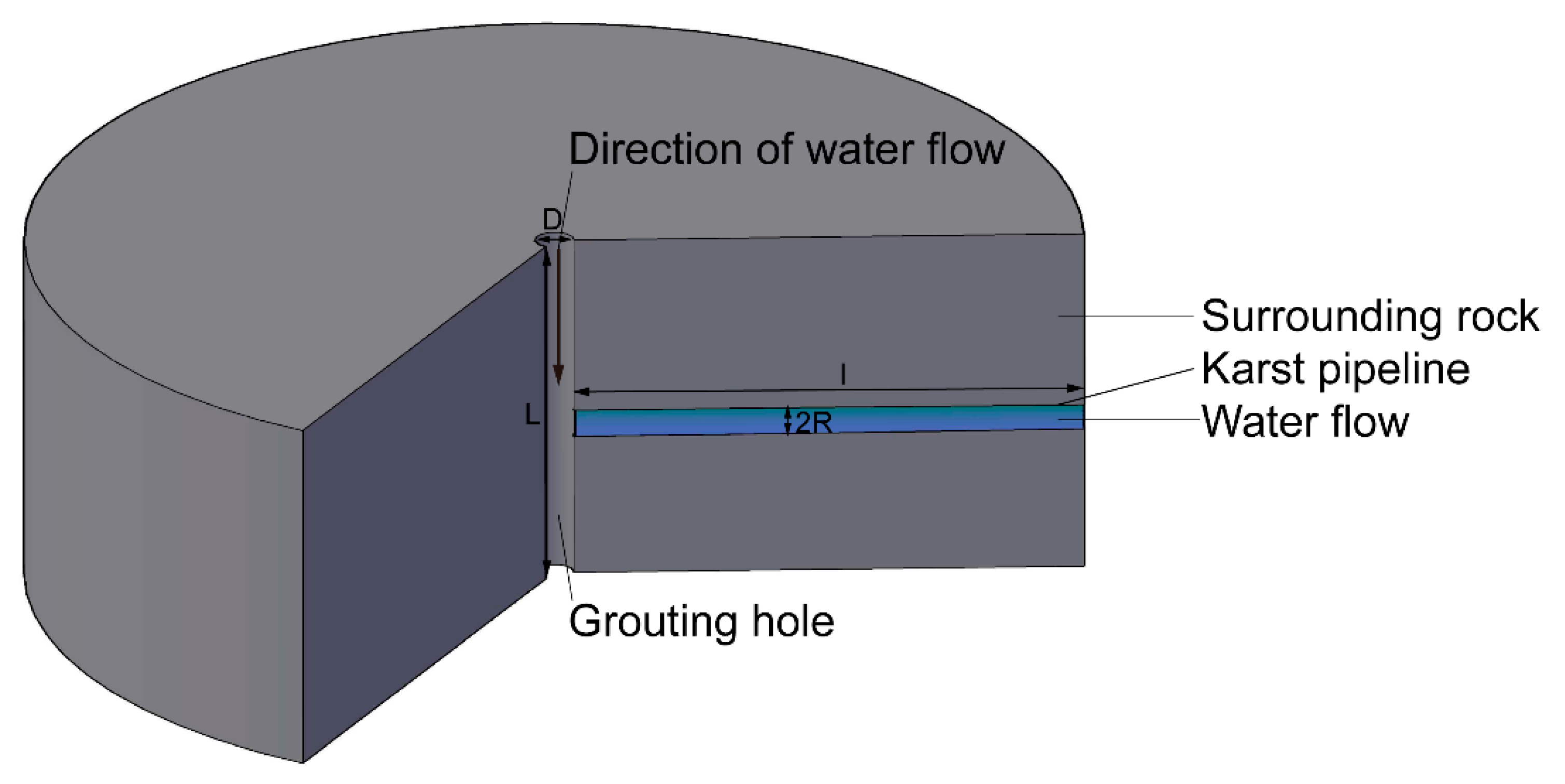
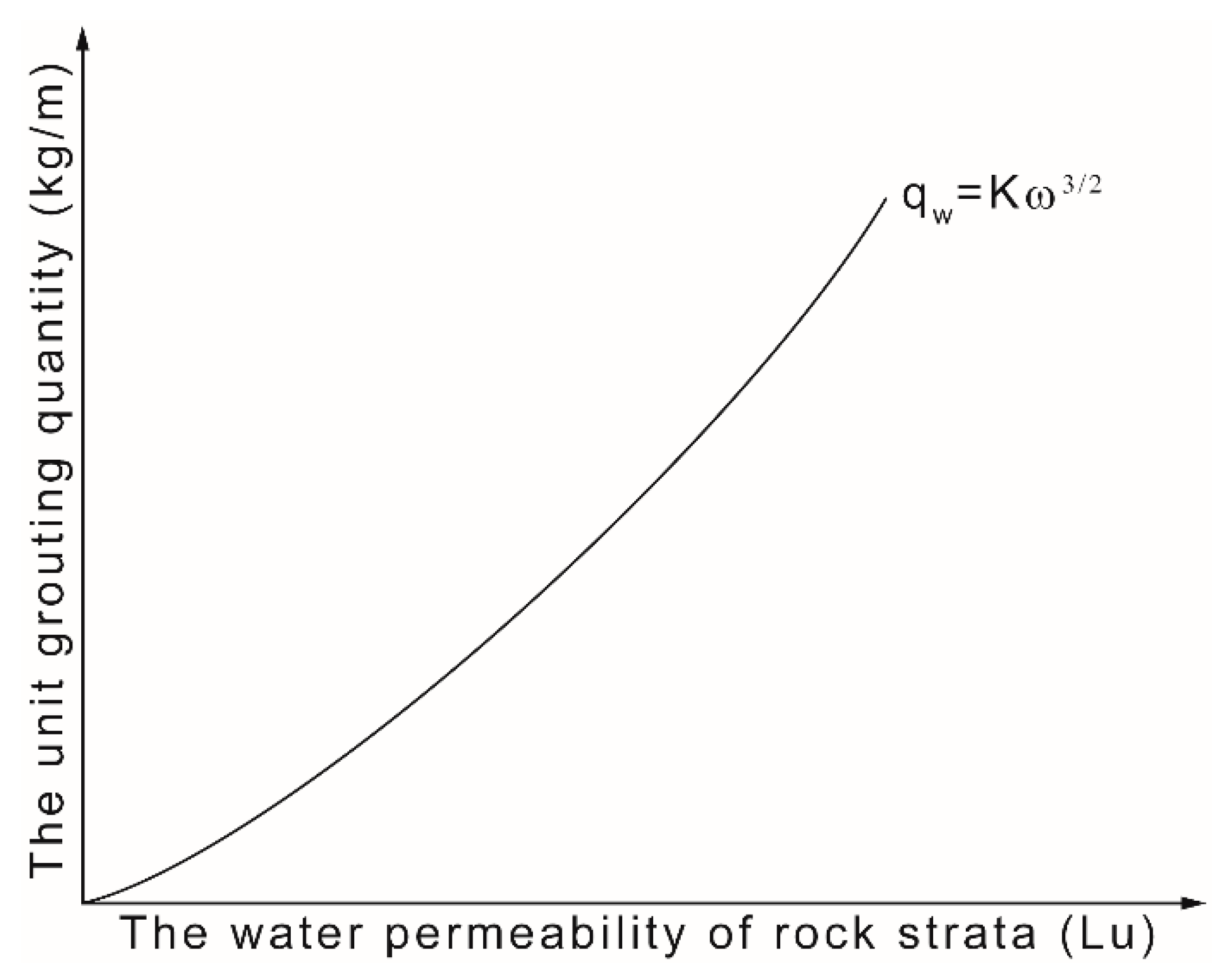
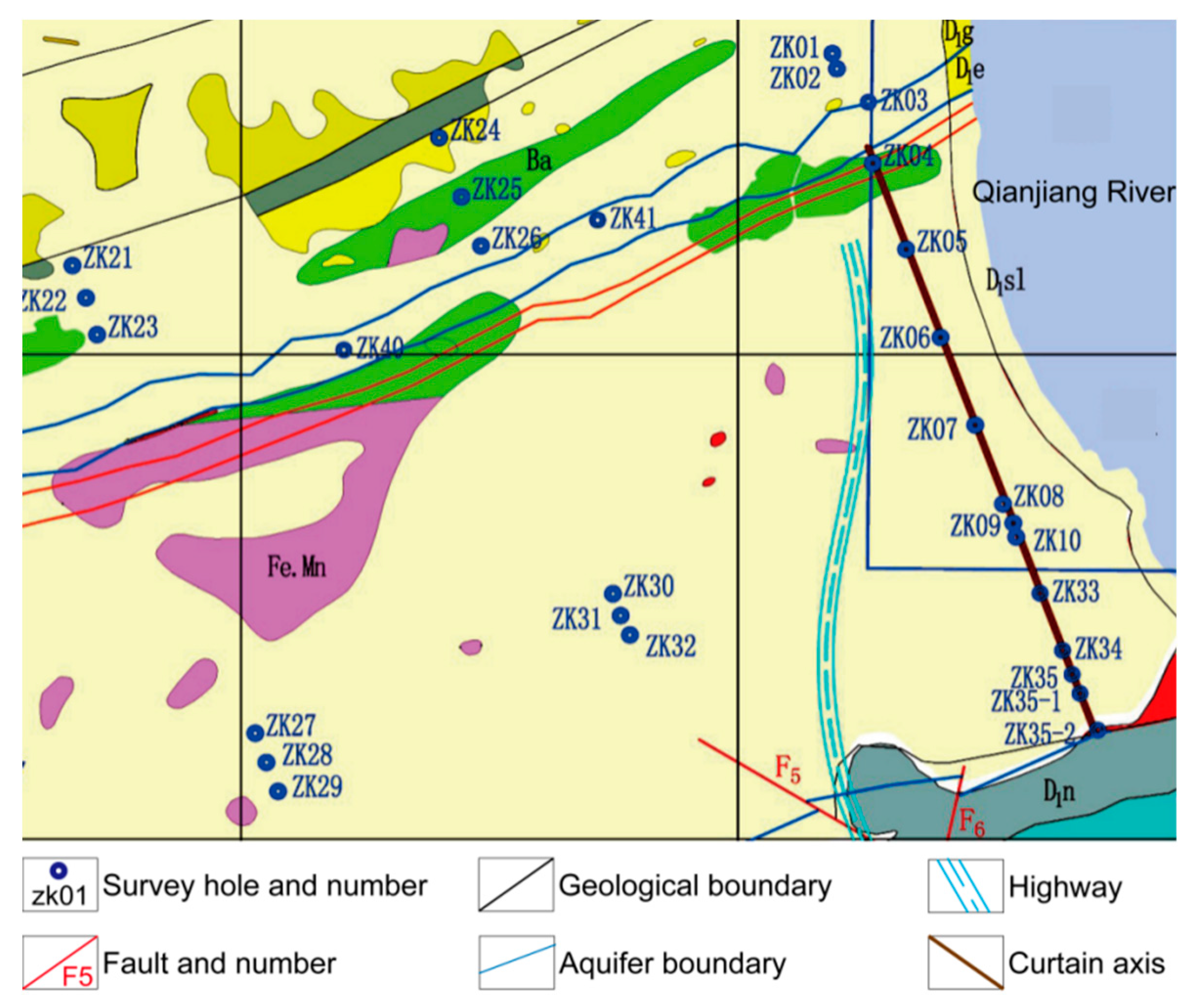
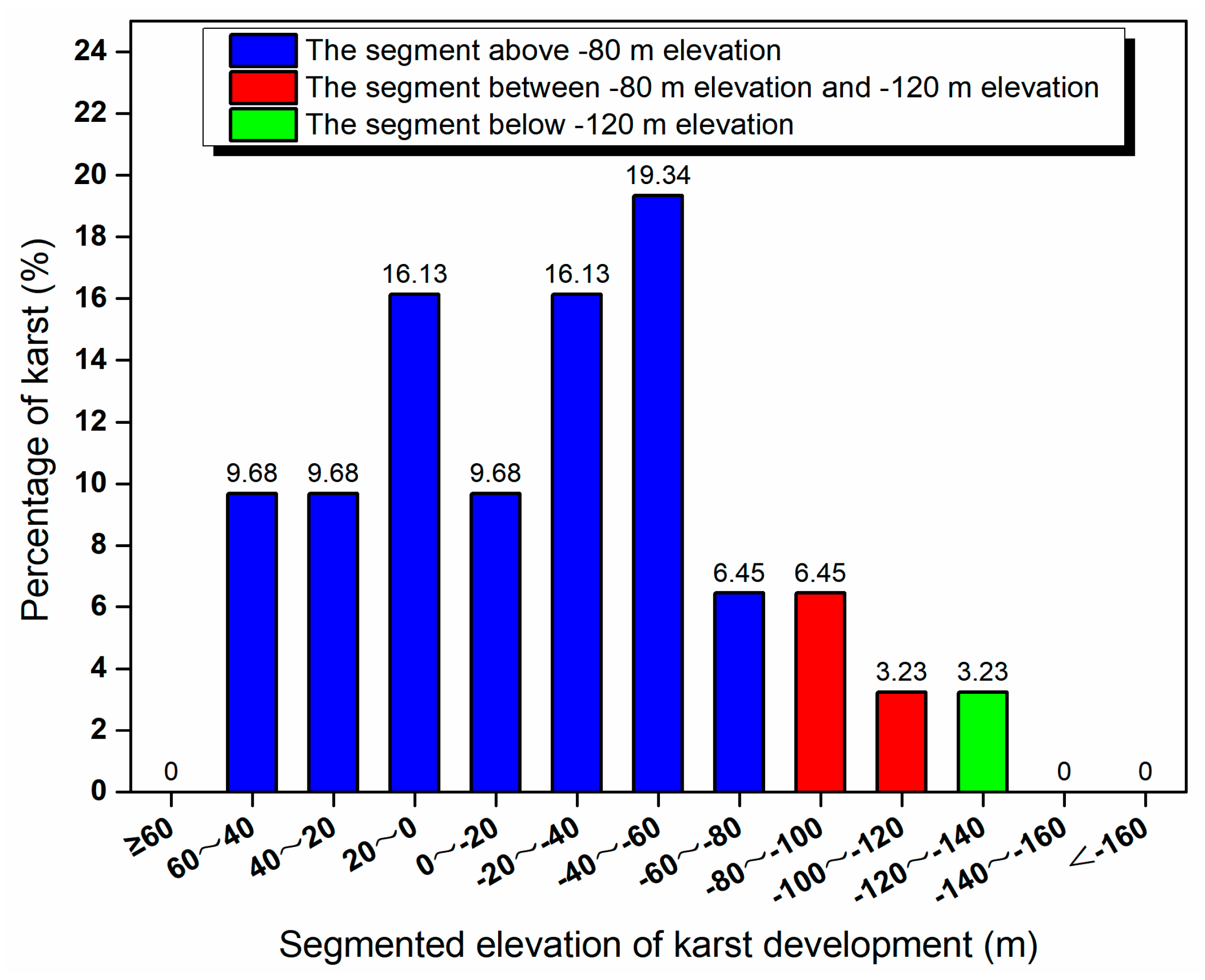
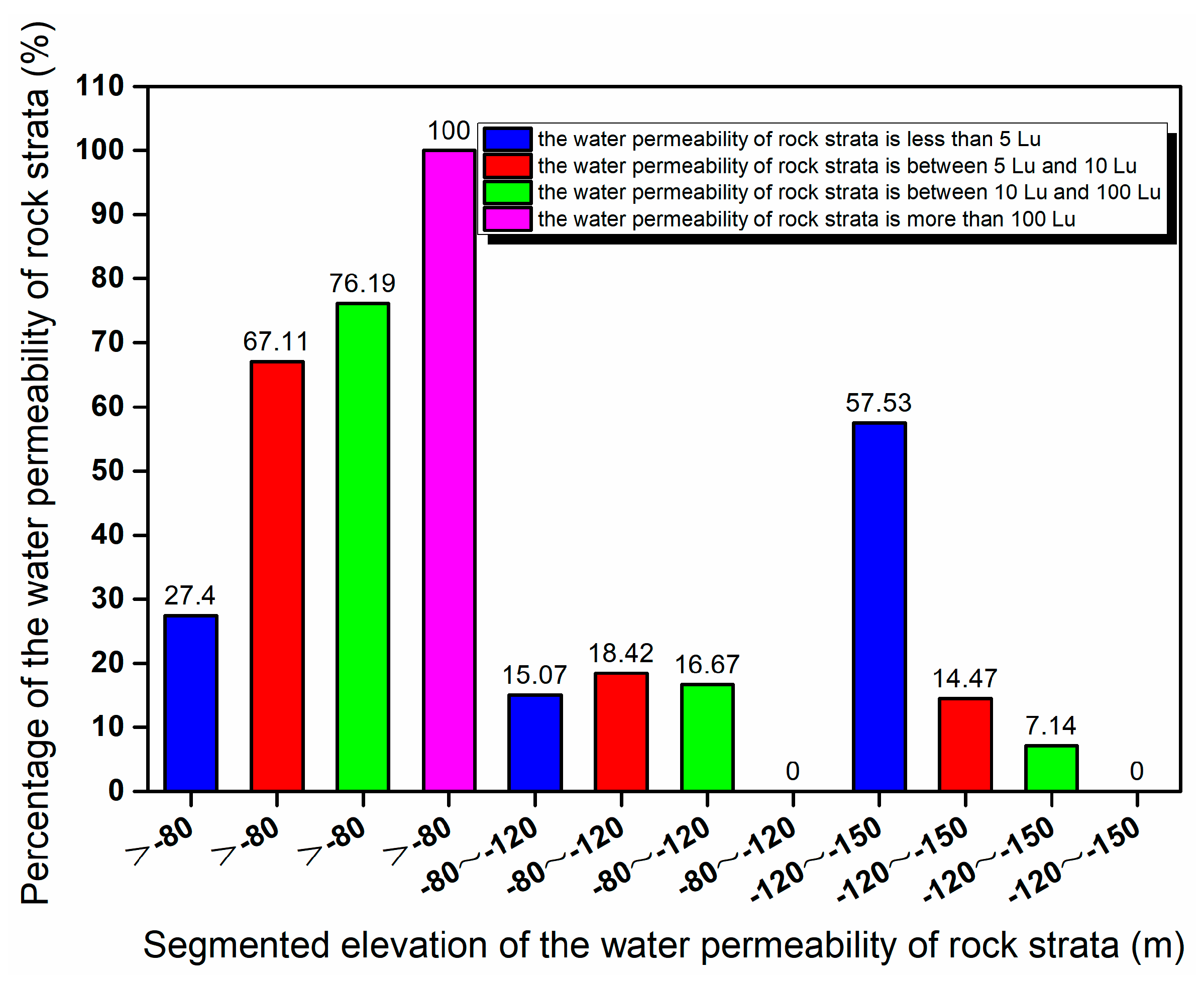
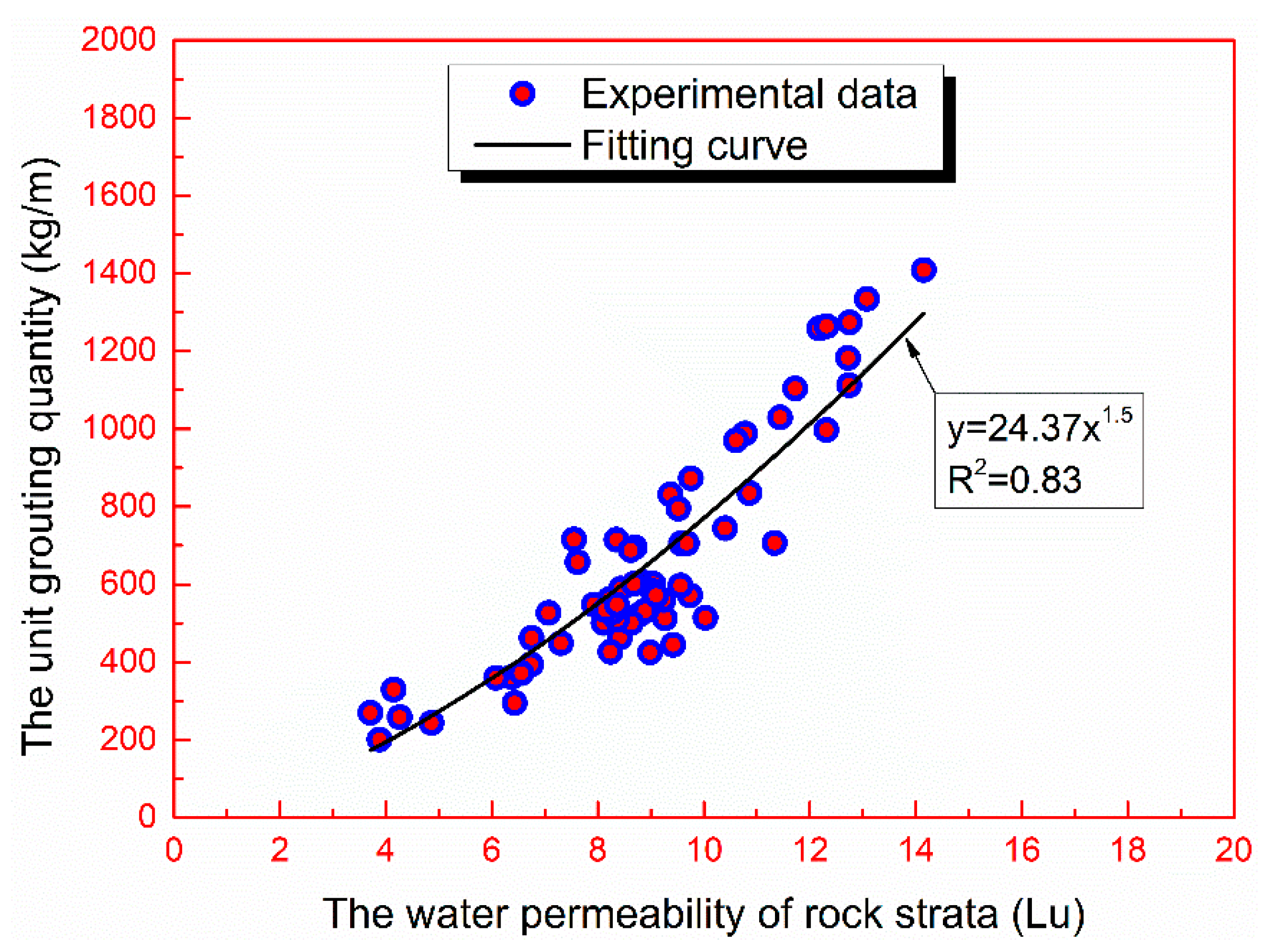
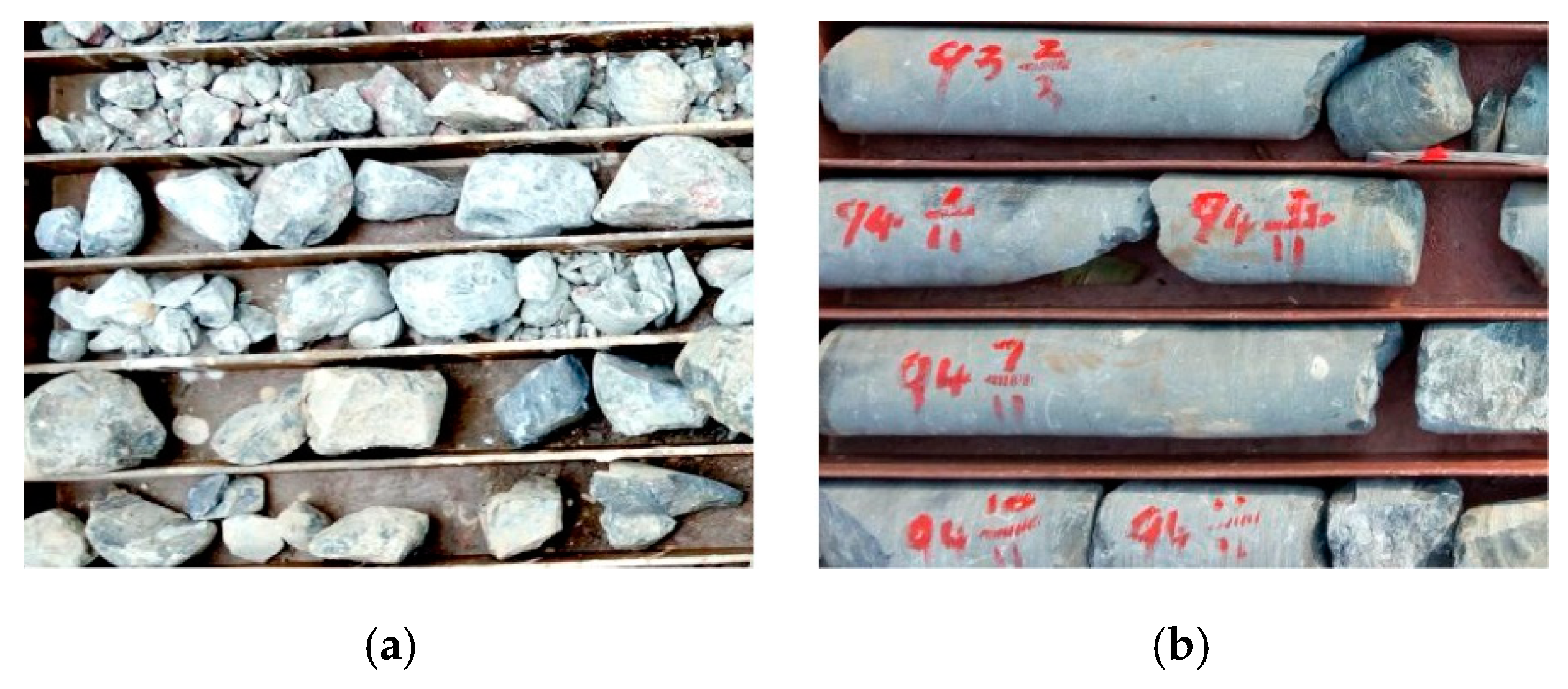
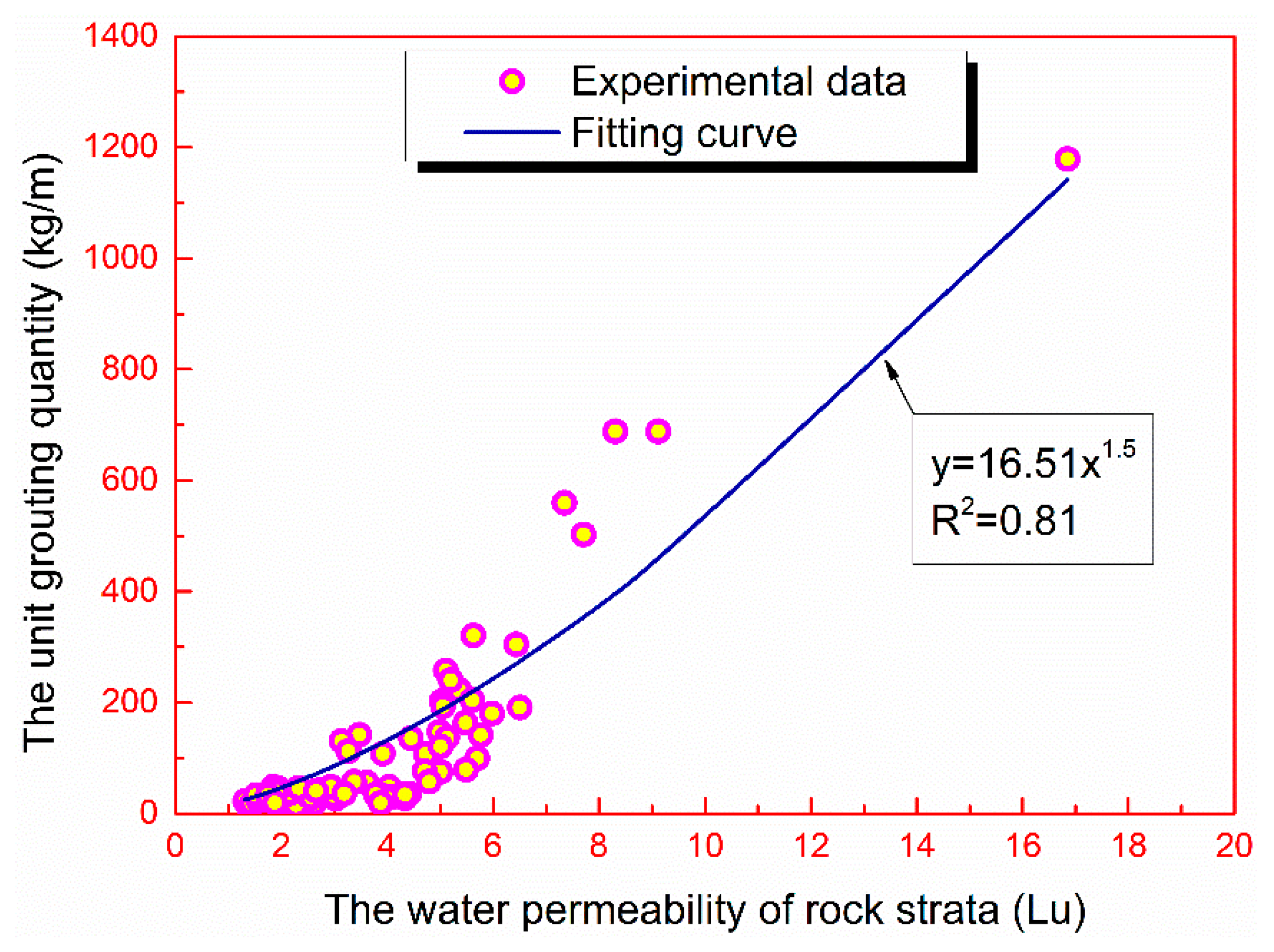
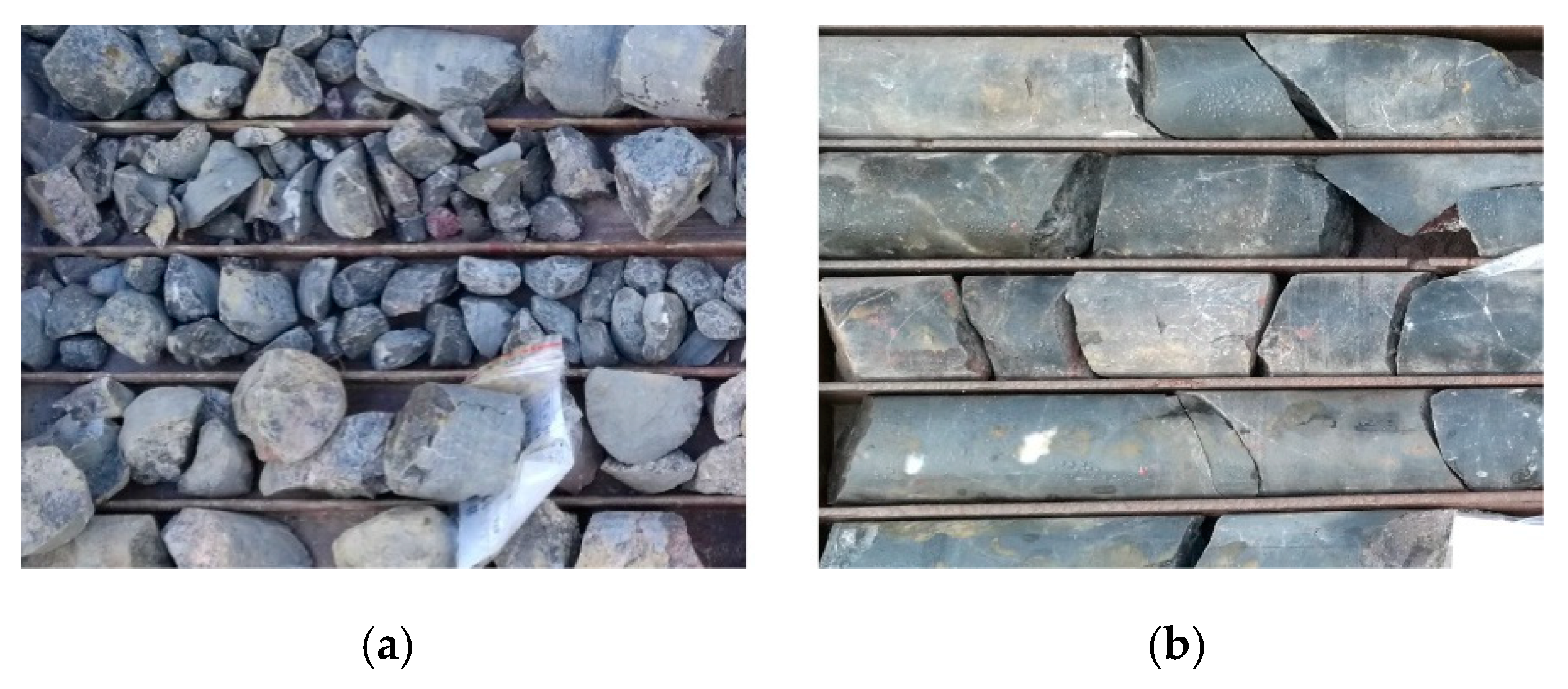
| Water Permeability of Rock Strata (Lu) | Unit Grouting Quantity (kg/m) |
|---|---|
| 1 | 24 |
| 2 | 69 |
| 3 | 127 |
| 4 | 195 |
| 5 | 272 |
| 6 | 358 |
| 7 | 451 |
| 8 | 551 |
| 9 | 658 |
| 10 | 771 |
| 11 | 889 |
| 12 | 1013 |
| 13 | 1142 |
| 14 | 1276 |
| 15 | 1416 |
| 16 | 1559 |
| 17 | 1708 |
| 18 | 1861 |
| 19 | 2018 |
| 20 | 2179 |
| Water Permeability of Rock Strata (Lu) | Unit Grouting Quantity (kg/m) |
|---|---|
| 1 | 17 |
| 2 | 47 |
| 3 | 86 |
| 4 | 132 |
| 5 | 185 |
| 6 | 243 |
| 7 | 306 |
| 8 | 374 |
| 9 | 446 |
| 10 | 522 |
| 11 | 602 |
| 12 | 686 |
| 13 | 774 |
| 14 | 865 |
| 15 | 959 |
| 16 | 1057 |
| 17 | 1157 |
| 18 | 1261 |
| 19 | 1368 |
| 20 | 1477 |
© 2019 by the authors. Licensee MDPI, Basel, Switzerland. This article is an open access article distributed under the terms and conditions of the Creative Commons Attribution (CC BY) license (http://creativecommons.org/licenses/by/4.0/).
Share and Cite
Niu, J.-D.; Wang, B.; Chen, G.-J.; Chen, K. Predicting of the Unit Grouting Quantity in Karst Curtain Grouting by the Water Permeability of Rock Strata. Appl. Sci. 2019, 9, 4814. https://doi.org/10.3390/app9224814
Niu J-D, Wang B, Chen G-J, Chen K. Predicting of the Unit Grouting Quantity in Karst Curtain Grouting by the Water Permeability of Rock Strata. Applied Sciences. 2019; 9(22):4814. https://doi.org/10.3390/app9224814
Chicago/Turabian StyleNiu, Jian-Dong, Bin Wang, Guan-Jun Chen, and Kang Chen. 2019. "Predicting of the Unit Grouting Quantity in Karst Curtain Grouting by the Water Permeability of Rock Strata" Applied Sciences 9, no. 22: 4814. https://doi.org/10.3390/app9224814
APA StyleNiu, J.-D., Wang, B., Chen, G.-J., & Chen, K. (2019). Predicting of the Unit Grouting Quantity in Karst Curtain Grouting by the Water Permeability of Rock Strata. Applied Sciences, 9(22), 4814. https://doi.org/10.3390/app9224814





